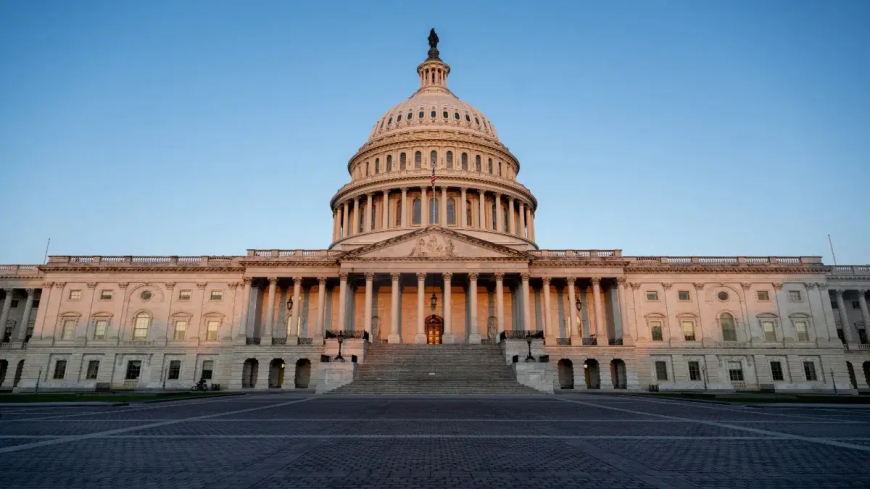US Government Shutdown: Why Did Congress Fail to Fund Federal Agencies? Impacts, History, and Economic Cost
The US Government Shutdown is official, marking the first in almost seven years. Learn why Congress failed to pass the necessary funding bill, how hundreds of thousands of employees are impacted, and the potential 0.2% hit to economic growth, according to analysts.

By: Dainik Realty Bureau | Date: | 01 OCT 2025
Breaking News: The US Government Shutdown has officially begun, representing the first governmental closure in nearly seven years. This crisis arose because the new fiscal year for the Federal Government commenced on October 1st, yet Congress failed to agree on a necessary short-term funding bill. Understanding the specifics of this financial and political stalemate is crucial, as a prolonged closure could slow economic growth, disrupt markets, and erode public confidence globally. The short-term spending bill, which lays out the funding for government operations until November 21, was introduced by the Republicans. Without this critical funding legislation, the government cannot function. This report explains the core legal reasons for the closure, the immediate effects on federal workers and essential services, and the estimated economic repercussions facing the US economy.
Why the US Government Shutdown Occurred: The Legislative Stalemate
The core reason for the US Government Shutdown is Congress’s inability to pass the necessary funding required for federal agencies to operate. The underlying legal mandate driving this closure is the Anti Deficiency Act, which was initially passed in 1884 and later amended in 1950. This act stipulates that federal agencies cannot spend or obligate any money without an appropriation or other approval from Congress. Although the Republican party controls both chambers of Congress, they require Democratic support to pass a funding bill in the Senate. Approval for a temporary spending bill in the Senate requires 60 votes. The sources indicate that the Republicans fell short of the votes needed to pass the legislation. Leading up to the deadline, the two main parties failed to craft a bipartisan bill, with the Senate rejecting both a GOP proposal and a Democratic proposal. This legislative failure meant that, by law, operations requiring new funding must cease until an agreement is reached.
Immediate Impact on Essential Services and Federal Employees
During a full or partial US Government Shutdown, hundreds of thousands of government employees might face immediate consequences, either being furloughed or made to work without pay. However, certain 'essential services' are legally mandated to continue operating, even without immediate appropriations. These critical services include:
- Social Security
- Military Duties
- Immigration Enforcement
- Air Traffic Control
While these essential functions continue, many other federal services may still be disrupted or delayed. For instance, disruptions may affect food safety inspections, immigration hearings, and air travel. The scale of impact can be substantial, as demonstrated by the 2018 shutdown under President Trump. During that closure, which lasted 34 days, approximately 800 thousand of the 2.1 million federal government employees were impacted.
Understanding the Difference Between Full and Partial Shutdown
A US Government Shutdown can take different forms depending on the legislative progress made by Congress. Federal funding involves 12 appropriation bills. If Congress manages to enact some, but not all, of these 12 appropriation bills, only the specific agencies lacking appropriations are forced to shut down. This scenario is known as a partial shutdown. In the current scenario, the failure to pass a necessary short-term spending bill signals a widespread lack of funding. Although essential services continue, the areas most affected during a shutdown are non-essential administrative functions, such as those related to research, parks, and museums.
Projected Economic Costs of a Prolonged Closure
While the broader economy may not register the impact of the US Government Shutdown immediately, a prolonged closure carries serious economic risks. A long-lasting closure has the potential to slow overall economic growth, disrupt financial markets, and weaken public confidence. According to some reports and analyst estimates, this specific shutdown is likely to be "bigger than the one in 2018". Analysts have provided quantitative estimates regarding the economic damage, projecting that the shutdown could "shave around 0.1 to 0.2 percentage points off economic growth for each week that it lasts". This anticipated negative impact underscores the severity of the political impasse and the need for a swift resolution.
Historical Context of the US Government Shutdown
The current closure is not unprecedented in US history. The sources highlight two significant recent examples of government shutdowns, both stemming from congressional disagreements over funding:
- 2018 Shutdown: This closure, resulting from a standoff between President Trump and Democrats, lasted for a record 34 days.
- 2013 Shutdown: Prior to 2018, the US government shut down for a total of 16 days because Congress could not agree on a budget for the new fiscal year.
The current event marks the first government shutdown in almost seven years, demonstrating a recurring challenge in US fiscal governance.
Conclusion
In summary, the US Government Shutdown is the result of the Senate failing to secure the necessary 60 votes to pass a bipartisan short-term funding bill, despite the required spending bill being introduced by Republicans. Although essential services like military duties and Social Security will continue, hundreds of thousands of employees are impacted, and analysts estimate that the economy may contract by 0.1 to 0.2 percentage points weekly for the duration of the closure. The future resolution depends entirely on the two parties successfully crafting a bipartisan bill in the Senate. Given that this shutdown is anticipated to be larger than the one in 2018, a prolonged impasse poses a significant threat to market stability and economic growth.
FAQs (5 Q&A)
1. What is the US Government Shutdown? A US Government Shutdown occurs when Congress fails to agree on funding bills, meaning federal agencies are legally restricted from spending money under the Anti Deficiency Act. During this time, government operations deemed "non-essential" must cease until funding is restored.
2. Why did the current US Government Shutdown happen? The current US Government Shutdown happened because Congress failed to pass the necessary short-term funding bill before the fiscal year deadline (October 1st). In the Senate, Republicans lacked the 60 votes required to approve a temporary spending bill, despite attempts to pass both GOP and Democratic proposals.
3. Will essential services stop during the US Government Shutdown? No, essential services will continue during the US Government Shutdown. Services such as military duties, Social Security payments, air traffic control, and immigration enforcement are considered essential and remain operational, even if a full or partial shutdown occurs.
4. How will the US Government Shutdown impact the economy? While the immediate impact may be negligible, a prolonged US Government Shutdown could slow economic growth, disrupt markets, and erode public confidence. Analysts predict that economic growth could be shaved by around 0.1 to 0.2 percentage points for every week the closure lasts.
5. How many employees were affected by the 2018 US Government Shutdown? The 2018 US Government Shutdown lasted 34 days and impacted approximately 800 thousand of the 2.1 million federal government employees. These employees were either furloughed or required to work without receiving immediate pay.







































